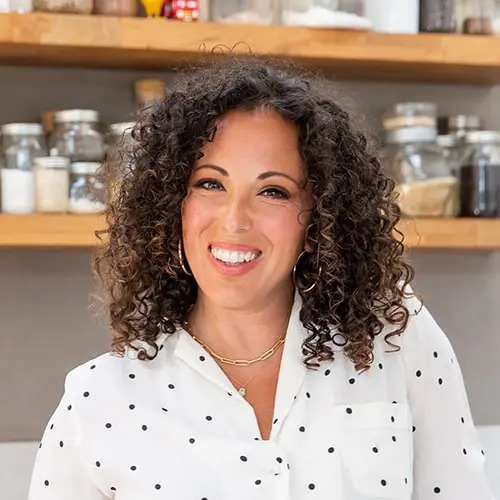You wake up on the day of your dream-job interview, look in the mirror… and there it is, a big pimple on your chin.
You wish you could blame it on nerves, but the truth is that lately your skin is more broken out than it was when you were a teenager. You don’t know what else to try…
- You’re already spending tons of cash on facials and trips to the dermatologist
- You’ve tried every “miracle” regimen at Sephora
- You even tried cutting back on nights out with your girlfriends!
But here’s what you don’t know… what you think is just “annoying adult acne” might actually be more than that. It could be a sign you have Polycystic Ovarian Syndrome.
I know what you’re thinking – you’ve heard of PCOS and you couldn’t possibly have it! You have normal cycles (well, at least your birth control pill makes them seem normal), you’re not overweight (although you do feel like you carry a bit more weight than you should, given how active you are), and you don’t have any other symptoms (except the acne… and your hair is thinning a bit… and the need to wax your lip every month…).
Listen girl, I get it! When I found out I had PCOS, I was shocked. But it turns out, I actually had a pretty atypical case. And you might too.
Misinformation about what PCOS is and the symptoms it can cause let many women slip through the cracks and never get the diagnosis or treatment they deserve.
Adult acne isn’t normal, and it isn’t something you should have to deal with. Finding the root cause of your acne and addressing it can mean clear skin and better health (because acne is always a sign of a bigger problem). And even if you’re certain you don’t have PCOS, keep reading anyways – you may be surprised by what you learn!
What PCOS Is (And Isn’t)
The #1 misconception about PCOS is that it is simply a condition where cysts develop on the ovaries. So wrong. In fact, some women with PCOS don’t even have cystic ovaries!
PCOS is actually the most common type of hormone and metabolism imbalance. It affects 1 out of 10 women. (Yes, that number is the same as 10% – a huge amount.)
Based on the Rotterdam Criteria from 2003, there are 3 diagnostic criteria for PCOS – and to be formally diagnosed, you have to have at least 2:
- Confirmed androgen excess on labs or androgen excess symptoms
- Ovulatory dysfunction
- Multiple cysts on ovaries (PCOM) diagnosed via imaging ultrasound
If you have at least 2 of the 3 criteria above, your doctor can diagnose you with PCOS.
In 2018 PCOS diagnosis guidelines were updated by a combined counsel of the Australian National Health and Medical Research Council, European Society of Human Reproduction and Embryology, and American Society for Reproductive Medicine.
It was a HUGE step forward in the treatment and diagnosis of PCOS, since the new guidelines (finally!) took into account how different PCOS can be in different women.
Here are their new recommendations:
- Androgen excess can be diagnosed by measuring free testosterone or bioavailable total testosterone. However, elevations in the hormones Androstenedione and DHEAS can also indicate PCOS, even without elevated testosterone.
- When irregular menstrual cycles are present, a PCOS diagnosis should be considered. Irregular is defined as cycles less than 21 days, greater than 35 days, or less than 8 cycles per year. However, ovulatory dysfunction can still occur with regular cycles – this can be confirmed or ruled out with serum progesterone levels taken in the second half of the cycle.
- Ultrasound should not be used for the diagnosis of PCOS in those less than 8 years out from their first period, because many younger women have multifollicular ovaries, even without having PCOS.
The new diagnostic criteria don’t mention weight – and that’s because your weight is not part of the diagnosis for PCOS. Only 30% of people with PCOS are overweight or obese. And pain is not a symptom of PCOS, either.
What Does PCOS Do To You?
The hormone imbalance in PCOS creates problems with how the ovaries function, so the egg that should develop each month may not, or may not be released during ovulation (aka anovulation).
Some women think that if they aren’t actively trying to get pregnant, anovulation is no big deal – but regular ovulation is a sign your body is humming. Many women with PCOS also experience irregular cycles. Again – this is more than just a fertility problem (though it is that too!) A healthy period is a sign your overall health (physical & mental) is good
(Side note – if your doctor prescribed the pill to regulate your cycle, this is still a problem! More on that later, so keep reading).
But PCOS is about way more than just ovulation.
Excess Androgens Are The Real Cause of Adult Acne
Women with PCOS tend to have an excess of androgens. Androgens are male hormones, and an excess can mean high testosterone, high DHEA, or high metabolites of either.
Excess androgens are responsible for some of the most dreaded PCOS symptoms like:
- Acne (especially on the chin, jaw, and back)
- Male pattern hair loss/thinning
- Hirsutism (male-pattern hair growth, like on the face)
- Anger, irritability, mood swings
- Poor stress response
- Increased anxiety and depression
Not every woman with excess androgens has all of the above symptoms – and sometimes one symptom can be severe (like acne!) while other can be more mild (maybe just a bit more hair on your upper lip).
But pay attention here – hormones levels are complex! Many women with PCOS also have symptoms of high estrogen. It commonly happens like this: DHEA is high, but progesterone is low relative to estrogen levels. On top of that, many women have poor estrogen detox because their liver is overburdened.
How PCOS Presents in Real Women
Remember, every woman is unique – but there’s a common scenario I see in my clinic with women with PCOS. And – full disclosure – I was one of these women too!
Here’s a story I hear from a typical PCOS patient with acne in my clinic about her teenage years/early 20s:
- Her period came in her later teens (or never started naturally)….or started “on time” but then had irregular long windows between
- Acne started to develop and so did hair in places she didn’t want it –(like nipples, lip, chin, stomach)
- She may have been put on oral birth control pills to “regulate” her period and help deal with the acne
- And she might have been put on antibiotics like tetracycline or Accutane to further help control the acne
Sound familiar to you?
Then, as she aged into her 20s and 30s:
- As other women’s acne clears up, hers is getting worse than ever
- She may start to gain weight around her middle (even if she remains thin), or struggle to control her weight despite a healthy lifestyle
- Her hair might lose its luster and start to thin
- She may notice more anxiety and depression, trouble recovering from stress
And if she decides to stop taking the pill, here’s what usually happens:
- Her period takes a long time to return after stopping the pill – or it NEVER comes back
- Can’t conceive easily or without intervention
Not all of these symptoms are drastic (although some women do have very dramatic symptoms as a result of PCOS) – they can be subtle annoyances that hint at a bigger underlying problem.
What Not To Do If You Have PCOS & Acne
Most doctors – be they GPs, gynecologists, or dermatologists – only think of acne as a cosmetic issue. They often don’t make the link between acne and bigger issues like PCOS or hormone imbalance – especially if your other symptoms are mild or masked by the artificial hormones in the pill.
So, if you go see your doctor complaining about acne, you’ll probably be given one of these 3 things:
- Oral contraceptives (birth control pills)
- Antibiotics like tetracycline
- Medications like Accutane
While these meds might help short-term for some women, in the long-run they only make PCOS symptoms worse. Research has shown women with PCOS already have a less diverse microbiome than women without PCOS (and, that increasing microbiome diversity may be an essential part of treatment). The pill, Accutane, and antibiotics all only further damage the microbiome (especially when you’re taking them long term!)
Our microbiome (aka all the bacteria living in our gut) are critical for hormone biotransformation – that means they help produce and then clear out hormones. To have healthy hormones, (and clear skin) you’ve got to have a healthy gut – and taking any of these common acne meds can wreck your gut!
(It always comes back to the gut!)
Don’t Panic!
If you’re reading this and thinking you may have PCOS – or are nodding along because you were prescribed the Pill and antibiotics to treat your acne – please don’t panic!
Our bodies are so resilient, and there is a lot you can do to balance your hormones. In Part Two of this article, I’ll explain exactly what you CAN do and how I help women with acne, hormone imbalances, and PCOS in my clinic. Check out Part Two here.
At the Reverse-Age Method, we believe in a holistic approach to perimenopause and beyond, that addresses the root causes of your symptoms (like insomnia, hot flashes, night sweats, erratic periods, fatigue, skin aging, weight gain, and brain fog)– to also slow the pace that your cells are aging. Whether it’s improving gut health, optimizing detox function, enhancing mitochondrial function, or building muscle mass, our comprehensive program has got you covered.
If you’re new here, be sure to check out our Blog Page for more insights and tips on how to thrive during perimenopause. Our blog is packed with practical advice, success stories, and the latest research to help you on your journey.
For more updates and community support, follow us on social media:
You May Also Like...
How To Treat Depression & Anxiety Holistically – Part Two
In Part One of this series, I delved into the fact that depression and anxiety are not problems of JUST the brain or…
PCOS 101: Everything You Need to Know About Polycystic Ovarian Syndrome
I’ve been where you are right now… Maybe your doctor just told you, “You have PCOS.” Maybe you’re questioning it…
Whether you’re looking for help with your gut, your hormones, or both, our team of practitioners work together to treat the WHOLE you – guiding you to a healthier mind, body, and spirit day by day.



